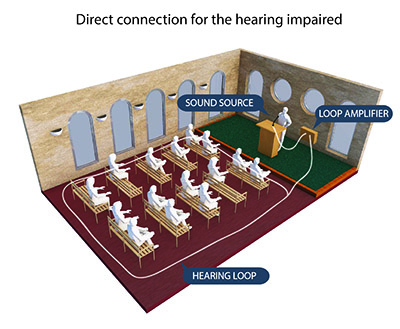Loops eliminate competing background noise, provide high frequency compensation, and require no additional equipment.
Understanding Hearing Loss and Hearing Loops
by Don Bataille
Hearing loss affects over 48 million Americans, 65% of those with hearing loss are still in the workforce or are in the educational fields. Hearing loss represents the third most prevalent condition among older adults following Arthritis and Heart Conditions. Two points need to be noted: First; hearing aids to do not restore hearing to pre-hearing loss levels but do improve hearing at normal conversation distances. Beyond normal conversation distances of 3 to 5 feet a person with hearing loss requires additional assistance to hear and understand speech sounds known as an assistive listening systems or (ALS). Second 90% of hearing loss occurs at high frequency sound levels; high frequency sounds make up the consonants that form word sounds and provide clarity of speech.
A hearing loop is an ALS, and has become the universal technology adopted by hearing aid manufacturers and is an integral part of ADA ‘Communication Accessibility’ requirements. ADA 2010, briefly, requires an ALS wherever amplified sound is being provided except for houses of worship or private clubs (unless rented for public use).
 Hearing loops are both old and new technology, originally developed for hearing aid users using land line telephones with a magnetic speaker, and have evolved into specific hearing loops systems serving large or small room applications to one-on-one applications. The “magic” of a hearing loop is its simplicity; a hearing aid user simply turns on their t-coil switch and instantly hears clear sound directly from the sound source as if the sound source is inches away from the person’s ear. The second part of the magic is that hearing loops provide high frequency compensation providing clarity of speech that a person’s hearing aid cannot provide.
Hearing loops are both old and new technology, originally developed for hearing aid users using land line telephones with a magnetic speaker, and have evolved into specific hearing loops systems serving large or small room applications to one-on-one applications. The “magic” of a hearing loop is its simplicity; a hearing aid user simply turns on their t-coil switch and instantly hears clear sound directly from the sound source as if the sound source is inches away from the person’s ear. The second part of the magic is that hearing loops provide high frequency compensation providing clarity of speech that a person’s hearing aid cannot provide.
Technically, a hearing loop is an Audio Frequency Induction Loop System. The loop is a wire installed in a specific design that sends a magnetic signal directly to a person’s hearing aid telecoil (T-coil), wirelessly. The loop eliminates competing background noise or room echo resulting in a clear sound signal that is delivered to the hearing aid or cochlear implant user. In the US the term ‘Hearing Loop’ is used while in Europe the term ‘Induction Loop’ is commonly used, In either case, both US and Europe comply with the same universal standard, IES 60118-4 for installation and testing of hearing loop systems.
Hearing loops are considered universal as they serve all people with hearing loss equally and in any hearing environment such as auditoriums, conference rooms, public events, teller counters, airports, family rooms, even taxi cabs and buses. Similar to other audio systems, hearing loops interface with standard audio devices such as a public address system, TV, radio, smart phone, or an iPod.
Hearing loops provide freedom and flexibility to join a group in a non-intrusive way, providing hearing aid users the ability to participate in meetings, public events, classrooms, and worship services. Non-hearing aid users benefit from a hearing loop with the use of a hearing loop receiver unit equipped with a headset or ear buds. Hearing loops do all of this at no additional cost to the hearing aid user.
- The advantages of a hearing loop are numerous:
- Loops provide a clear direct sound signal to one’s hearing aid without an intermediate (body worn) device, typical of other assistive listening systems.
- Loops eliminate disrupting background noise and room echo, ‘beneficial signal to noise ratio’.
- Loops do not call attention to hearing aid users by requiring them to locate, to check out and to wear a previously worn device around their neck.
- Hearing loops allow and enable the hearing aid user to manage their own hearing environment.
Donald W. Bataille, Architect and Owner of ‘Hearing Loops Unlimited, LLC; is a certified loop system designer and installer representing Contacta, Univox, Listen Technologies and Williams Sound. Don is active member and supporter of Hearing Loss Association of America (HLAA), and is a bilateral hearing aid user. .